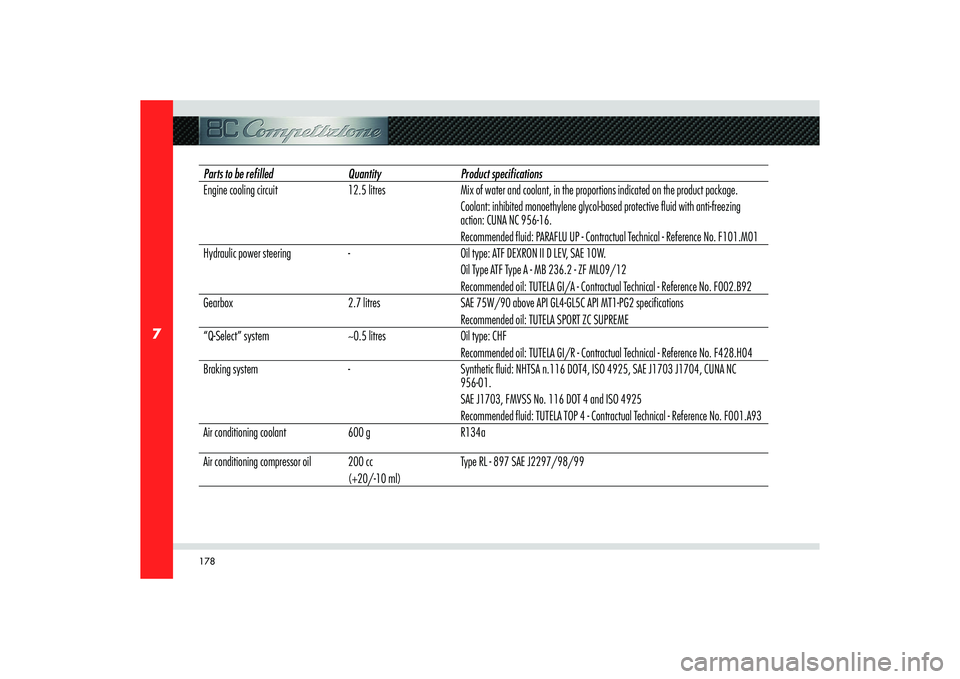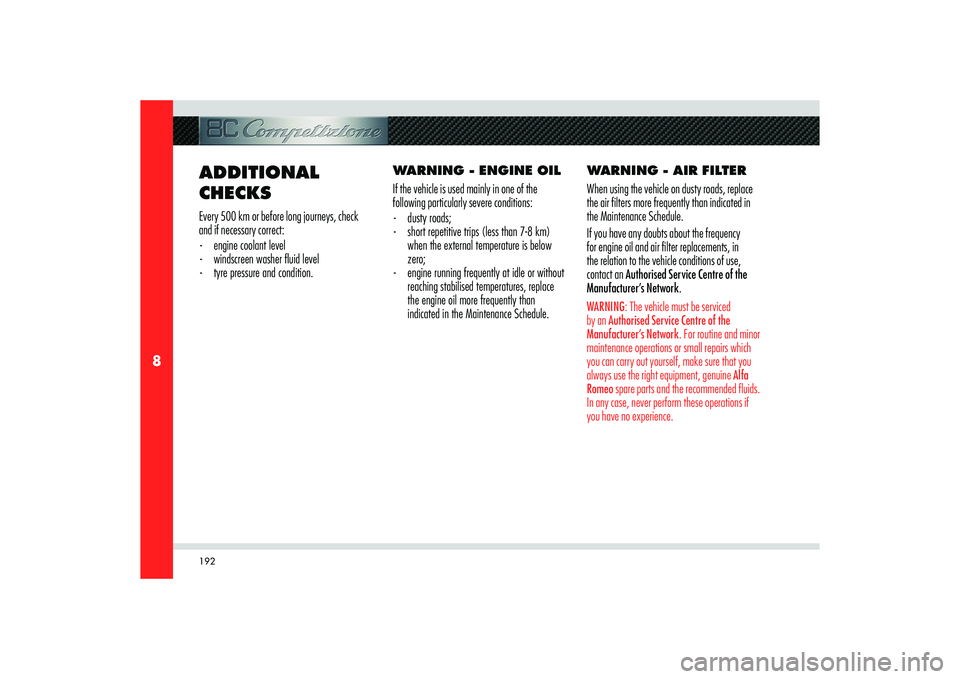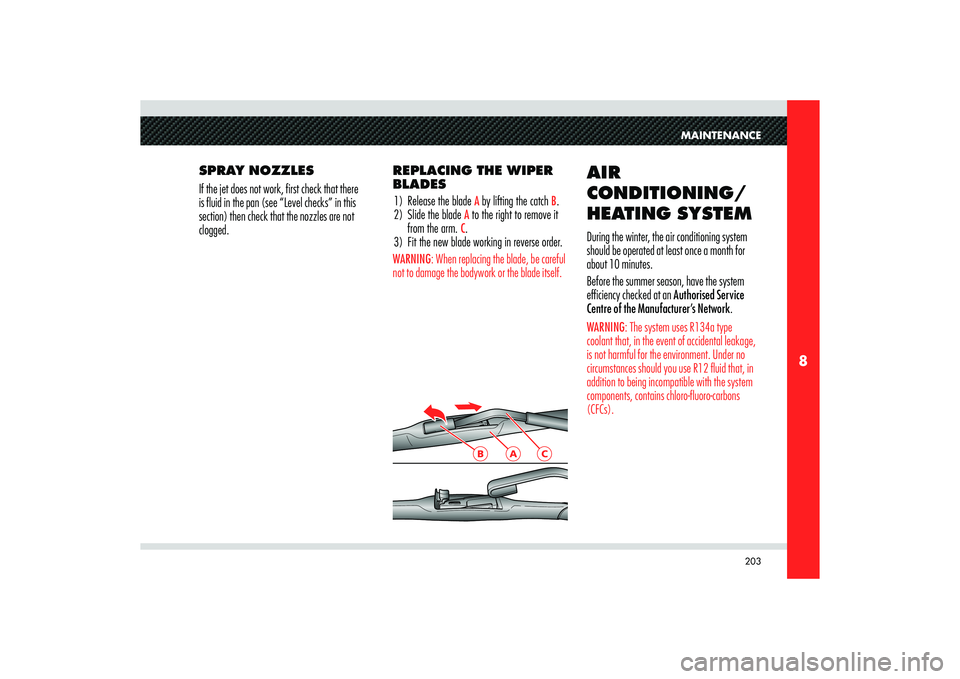air condition Alfa Romeo 8C 2009 Owner handbook (in English)
[x] Cancel search | Manufacturer: ALFA ROMEO, Model Year: 2009, Model line: 8C, Model: Alfa Romeo 8C 2009Pages: 223, PDF Size: 14.35 MB
Page 134 of 223

132
5
TRAVELLING
- Caution is the fi rst rule for safe driving.
Being careful also means being in a position
to be able to predict the driving behaviour
of other drivers, that may be wrong or
careless.
- Keep a safe distance from vehicles in front
of you, adjusting this distance in accordance
to the vehicle speed and traffi c conditions.
- Strictly follow the traffi c regulations
applicable in each country and above all,
respect the speed limits.
- Long trips should be started in optimal
physical condition.
CAUTION
Drunk driving, or driving
under the influence of drugs or certain
medicines is extremely dangerous for
the driver and for others.CAUTION
Always fasten the seat belts.
Travelling without your seat belt
fastened increases the risk of serious
injury in the event of a collision.
- Make regular stops to loosen up your limbs
and refresh yourself, and avoid driving for
hours on end.
- Ensure that the air inside the passenger
compartment is changed constantly.
- Never coast downhill with the engine off:
the braking action requires greater effort on
the pedal due to the absence of the engine
brake and the power braking system. DRIVING AT NIGHT
The main guidelines to follow when driving at
night are set out below:
- Drive with the greatest caution: at night the
driving conditions are more demanding.
- Reduce your speed, especially on roads with
no street lights.
- At the fi rst signs of drowsiness, stop: to
continue driving would be a risk for yourself
and for others. Continue only after you have
had a rest.
- Keep the vehicle at a greater distance from
vehicles in front of you than you would
during the day: it is diffi cult to assess the
speed of other vehicles when you can only
see the lights.
- Make sure that the headlights are aimed
correctly: if they are too low, they reduce
visibility and strain the eyes. If they are too
high, they may bother the drivers of other
cars.
Page 135 of 223

133
5
USING THE VEHICLE
- Use the high beams only outside of urban
areas and when you are sure that they will
not disturb other drivers.
- When another vehicle is approaching,
switch the high beams (if on) to low
beams.
- Keep the lights and headlights clean.
- Outside urban areas, beware of animals
crossing the road. DRIVING IN THE RAIN
Rain and wet roads are dangerous. On a wet
road all the manoeuvres are more difficult since
wheel grip on the asphalt is significantly reduced.
This means that the braking distances increase
considerably and the road holding decreases.
Certain advice for driving in the rain follows:
- Reduce your speed and keep a greater
safety distance from the vehicles in front
of you. High speed may result in a loss of
control and aquaplaning.
- Heavy rain also substantially reduces
visibility.
- Set the Air Conditioning controls to
demisting, in order to avoid any visibility
problems.
- Periodically check the conditions of the
windscreen wiper blades. DRIVING IN FOG
If the fog is dense avoid travelling where
possible.
When driving in mist, blanket fog or when there
is the possibility of banks of fog:
- Keep a moderate speed.
- Turn on the rear fog lights. Do not use the
main beam.
- Remember that fog creates dampness on
the asphalt and thus any type of manoeuvre
is more diffi cult and braking distances are
greater.
- Keep a safe distance from the vehicle in
front of you.
- Avoid sudden changes in speed as much as
possible.
- Whenever possible, avoid passing other
vehicles.
- If you are forced to stop the vehicle
(breakdowns, impossibility of proceeding
due to poor visibility, etc.), fi rst of all, try to
stop off of the travel lane. Then turn on the
hazard warning lights and if possible, the
low beams.
Page 149 of 223

147
6
ABIN AN EMERGENCY
TOOLKIT
The vehicle is equipped with the following tools:
- toolkit, housed in the luggage compartment
- box with electric compressor, jack and
tools for fi tting the spare wheel (optional),
located inside the spare wheel itself.
The toolkit, housed under the floor panel,
contains:
- 8 + 10 open end wrench
- 13 + 17 open end wrench
- double slot + cross-head screwdriver
- tow hook
- Electric parking brake actuator release tool
IF A TYRE GETS A
PUNCTURE PRECAUTIONS IN THE
EVENT OF A PUNCTURE
If a tyre gets a puncture, you can make a first
emergency repair using the tyre repair kit
provided.
This kit allows repairing tyre punctures of up to
6 mm (7/32 in); the kit can be used in any
atmospheric condition.
Do not remove the foreign body (e.g. screw or
nail) from the punctured tyre.
Take the repair kit out of the bag found in the
luggage compartment and position it near the
punctured tyre.Screw the flexible inflation hose
A, onto the
pneumatic valve
B.
Page 180 of 223

178
7
Parts to be refi lled Quantity Product specifi cations
Engine cooling circuit 12.5 litres Mix of water and coolant, in the proportions indicated on the product package.
Coolant: inhibited monoethylene glycol-based protective fluid with anti-freezing
action: CUNA NC 956-16.
Recommended fluid: PARAFLU UP - Contractual Technical - Reference No. F101.M01
Hydraulic power steering - Oil type: ATF DEXRON II D LEV, SAE 10W.
Oil Type ATF Type A - MB 236.2 - ZF ML09/12
Recommended oil: TUTELA GI/A - Contractual Technical - Reference No. F002.B92
Gearbox 2.7 litres SAE 75W/90 above API GL4-GL5C API MT1-PG2 specifications
Recommended oil: TUTELA SPORT ZC SUPREME
“Q-Select” system ~0.5 litres Oil type: CHF
Recommended oil: TUTELA GI/R - Contractual Technical - Reference No. F428.H04
Braking system - Synthetic fluid: NHTSA n.116 DOT4, ISO 4925, SAE J1703 J1704, CUNA NC
956-01.
SAE J1703, FMVSS No. 116 DOT 4 and ISO 4925
Recommended fluid: TUTELA TOP 4 - Contractual Technical - Reference No. F001.A93
Air conditioning coolant 600 g R134a
Air conditioning compressor oil 200 cc
(+20/-10 ml)Type RL - 897 SAE J2297/98/99
Page 181 of 223

179
7
CAPACITIES AND TECHNICAL SPECIFICATIONS
FUEL
CONSUMPTIONThe fuel consumption values shown in the
following table were established based on
homologation tests prescribed by specific
European Directives.
The test procedures followed for fuel
consumption measuring are described below:
- City cycle: This test begins with a cold start,
followed by simulation of an urban route;
- Highway cycle: This test involves frequent
accelerations in all gears, simulating use of
the vehicle on routes outside urban areas;
the speed varies between 0 and 120 km/h
- Average fuel consumption: This is
calculated considering a route consisting
of about 37% city cycle and 63% highway
cycle.FUEL CONSUMPTION FOLLOWING THE 2004/3/EC
DIRECTIVE (LITRES PER 100 KM)
City Highway Average
23.6 11.4 15.8WARNING: The type of route, traffic and weather conditions, driving style, general condition of the
vehicle, equipment/accessories in the vehicle, use of the air conditioning system, vehicle load and other
items or situations which may negatively affect the vehicle aerodynamics or wind resistance lead to
consumption ratios differing from the indicated ones.CO
2 EXHAUST EMISSIONS
The CO
2 exhaust emission ratings shown in the following table refer to an average fuel consumption.
CO2 EMISSIONS ACCORDING TO (*) DIRECTIVE
2002/80B/EC (G/KM)
City Highway Average
567 270 377
Page 191 of 223

8
MAINTENANCE
Scheduled Maintenance ...................................................................................................... 190
Additional checks ............................................................................................................... 192
Level checks ..................................................................................................................... 193
Air fi lter ............................................................................................................................ 197
Anti-dust/anti-pollen fi lter ................................................................................................... 197
Battery ............................................................................................................................. 198
Electronic control units ........................................................................................................ 199
Spark plugs ...................................................................................................................... 200
Wheels and tyres ............................................................................................................... 200
Windscreen wipers .............................................................................................................202
Air conditioning/heating system .......................................................................................... 203
Bodywork ......................................................................................................................... 204
Interiors ........................................................................................................................... 206
If the vehicle is laid up for long periods ................................................................................. 207
Radio-frequency remote control: Ministerial homologation ....................................................... 211
Conversion table ................................................................................................................ 212
Page 194 of 223

192
8
ADDITIONAL
CHECKSEvery 500 km or before long journeys, check
and if necessary correct:
- engine coolant level
- windscreen washer fl uid level
- tyre pressure and condition.WARNING - ENGINE OIL
If the vehicle is used mainly in one of the
following particularly severe conditions:
- dusty roads;
- short repetitive trips (less than 7-8 km)
when the external temperature is below
zero;
- engine running frequently at idle or without
reaching stabilised temperatures, replace
the engine oil more frequently than
indicated in the Maintenance Schedule. WARNING - AIR FILTER
When using the vehicle on dusty roads, replace
the air filters more frequently than indicated in
the Maintenance Schedule.
If you have any doubts about the frequency
for engine oil and air filter replacements, in
the relation to the vehicle conditions of use,
contact an Authorised Service Centre of the
Manufacturer’s Network.
WARNING: The vehicle must be serviced
by an Authorised Service Centre of the
Manufacturer’s Network. For routine and minor
maintenance operations or small repairs which
you can carry out yourself, make sure that you
always use the right equipment, genuine Alfa
Romeo spare parts and the recommended fluids.
In any case, never perform these operations if
you have no experience.
Page 199 of 223

197
8
MAINTENANCE
AIR FILTERHave the air filter replaced at an Authorised
Service Centre of the Manufacturer’s
Network.
ANTI-DUST/ANTI-
POLLEN FILTERThis filter performs mechanic/electrostatic air
filtering, provided that windows and doors are
fully closed.
Have the anti-pollen/dust filter replaced at least
once a year, at an Authorised Service Centre of
the Manufacturer’s Network preferably at the
beginning of the warm season.
If the vehicle is mainly used in the city traffic,
on highways or dusty roads, we recommend
that you replace the filters more frequently than
prescribed in the Maintenance Schedule.
WARNING: Failure to replace the filter may
considerably reduce the air conditioning and
heating system efficiency.
CAUTION
We advise you to have the
anti-pollen/dust filter replaced at
an Authorised Service Centre of the
Manufacturer’s Network.
Page 201 of 223

199
8
MAINTENANCE
WARNING: If the battery charge remains
below 50% for a long period of time, it will be
damaged due to sulphating: this will reduce its
performance and starting power and the battery
will be more subject to freezing (this can happen
even at -10°C).We recommend that you have the battery charge
condition checked, preferably at the beginning of
the cold season, to prevent the electrolyte from
freezing.
This check should be performed more frequently
if the vehicle is used mainly for short trips or if it
is equipped with power absorbing devices that
remain permanently on even if when the ignition
key is removed. This applies above all if these
devices have been fitted “after market”.
If the vehicle is not used for long periods of time,
please refer to chapter “If the vehicle is laid up
for long periods”, in this section.WARNING: If additional systems have to be
fitted in the vehicle, there is the risk of creating
dangerous branches on the electric wiring, in
particular if the safety devices are involved.
ELECTRONIC
CONTROL UNITSNo special precautions are required for the
normal use of the vehicle.
In the event of repairs to the electrical system
or in an emergency starting, the following
instructions must be strictly followed:
- Never disconnect the battery from the
electrical system when the engine is
running.
- Disconnect the battery from the electrical
system when recharging it (see page 168
“If the battery is fl at”). WARNING: When the battery is disconnected,
you must first detach the negative pole terminal
(–) and then the positive pole one (+).
WARNING: The battery is secured inside the
vehicle by means of a metal box, therefore, be
extremely careful not to let the battery charger
clips come into contact with it.WARNING: When the battery is reconnected,
you must first attach the positive pole (+),
remembering to cover it with the cap provided,
and then the negative one (–).
- Never perform the emergency starting
procedure using a battery charger: always
use an auxiliary battery.
- Take special care when connecting the
battery to the electrical system, checking
both that polarity is correct and that the
connection is properly working.
- Do not connect or disconnect the terminals
of the ECUs when the ignition key is at
MAR.
- Do not check the electric polarities through
sparking.
- Disconnect the ECUs in the event of
electrical welding on the vehicle body.
Remove them if the temperature is
over 80°C (special interventions on the
bodywork, etc.).
Page 205 of 223

203
8
B
A
C
MAINTENANCE
SPRAY NOZZLES
If the jet does not work, first check that there
is fluid in the pan (see “Level checks” in this
section) then check that the nozzles are not
clogged.REPLACING THE WIPER
BLADES
1) Release the blade
A by lifting the catch
B.
2) Slide the blade
A to the right to remove it
from the arm. C.
3) Fit the new blade working in reverse order.
WARNING: When replacing the blade, be careful
not to damage the bodywork or the blade itself.
AIR
CONDITIONING/
HEATING SYSTEMDuring the winter, the air conditioning system
should be operated at least once a month for
about 10 minutes.
Before the summer season, have the system
efficiency checked at an Authorised Service
Centre of the Manufacturer’s Network. WARNING: The system uses R134a type
coolant that, in the event of accidental leakage,
is not harmful for the environment. Under no
circumstances should you use R12 fluid that, in
addition to being incompatible with the system
components, contains chloro-fluoro-carbons
(CFCs).